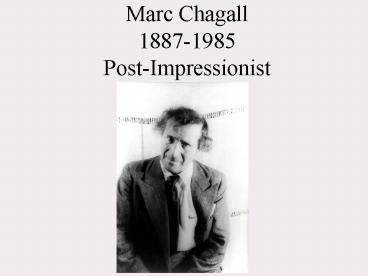Marc Chagall 18871985 PostImpressionist PowerPoint PPT Presentation
1 / 11
Title: Marc Chagall 18871985 PostImpressionist
1
Marc Chagall1887-1985Post-Impressionist
2
ChildhoodI and the Village
- The eldest of 9 children, his father was a poor
herring worker. His mother raised the children. - His family was close-knit, boisterous and happy.
- He was born in Belarus, then a part of Russia.
His family was Jewish at a time when much of
Eastern Europe was anti-Semitic. - -----------------------------------
- What shapes do you see?
- Do you see a town? A tree? Two horses?
3
EducationThe Fiddler
- He moved to St. Petersburg in 1907 to study
painting. Jews needed a special permit to live
in the city, and he was briefly arrested when he
didnt have the proper documents. - He married Bella from his hometown. He was
devoted to her until her death in 1944. - They briefly moved to Paris, but returned to
Russia prior to the outbreak of WWI. - --------------------------------------
- Some say this picture was the basis for the play
Fiddler on the Roof. - Is the mood happy? Sad? Quiet?
4
Early InfluencesBlue House
- Chagall and his wife supported the Russian
Communist Revolution, which erupted in 1917.
Initially pleased with the new regime, Chagall
grew disenchanted and moved to France, where he
was based for the rest of his long life. - He became well known to the surrealists and other
artists of his day. Surrealists focused on a
more subjective, thought provoking presentation
in their art than traditional sources.
5
DreamscapesBirthday
- He was inspired by Russian folk-life and biblical
themes. - His palette grew brighter as he aged, but the
same whimsy remained. He often talked of seeing
his pictures in his dreams and tried to convey
that same sense of magic and fantasy in most of
his works. - Here, notice how the feet dont touch the floor.
6
Dark SideWhite Crucifixion
- This unusually dark work is said to be a
denunciation of the persecution of the Jews under
both Stalin in Russia and Germany in WWII. - Political views are sometimes woven into his
work, often through symbols. Here, the
candelabra represents Judaism. - -----------------------------------
- Is this a happy scene? What is the source of
light? Do you think the figures are trying to
leave the frame?
7
The Wedding
- Although influenced by cubism and fauvism,
Chagall struck his own path and is difficult to
categorize. Cubism involved breaking forms down
into their most basic shapes. Fauvism (foe-vism)
refers to a movement involving Matisse where
bright colors and impressionist techniques were
used. - Though his works are sometimes called surreal,
his sensibility is very different, perhaps
because most of his works are tender and joyous.
Many surrealists used the juxtaposition of
objects to give a negative comment on life.
8
Mixed mediaStained Glass Window at the UN
- Chagall worked in virtually every type of
media--ceramics, stained glass, oil painting,
pastels, and sculpture. - He said, I work in whatever medium likes me at
the moment. - Does his work feel different when its done with
glass? - Do you like this work? Why?
9
Whimsical
- This work is typical of Chagall. Note the color
palette--both vivid color and delicate whites. - Do you see one face? Two faces? Three? Is it a
man or a woman? - Are angels circling the head? Devils?
- Do you think the person is happy? Generous?
- Do you feel like you are looking at a a picture
from someones dream?
10
Marriage
- Chagall used lots of symbolism in his work.
- A tree long life
- A clock passing time
- A horse freedom
- A rooster marriage
- Instruments rituals
- Eiffel Tower freedom
- -------------------------------
- Do you see the instruments? Roosters? Floating
people? - Does it capture the joy of a wedding, if not the
form?
11
Great art picks up where nature ends.
- These works, Enchantment and Promenade typify
the romantic and delicate feel of much of
Chagalls masterpieces. - Chagall created compulsively, even writing poetry
and penning his own memoir. He believed that
the act of creating was an affirmation of life
itself. He died at 97, with his life spanning
the great tumult of the 20th century.

